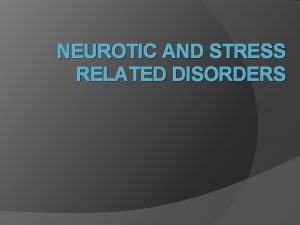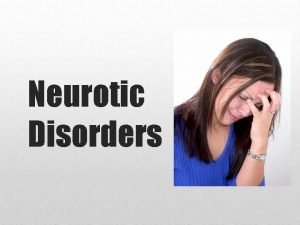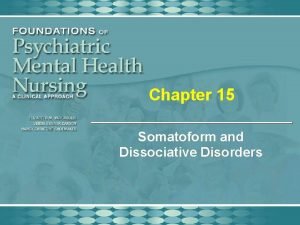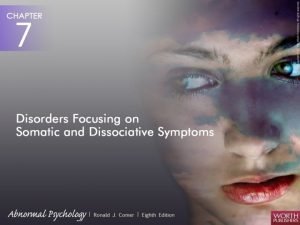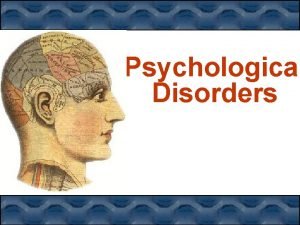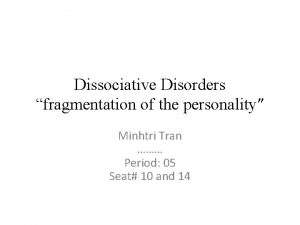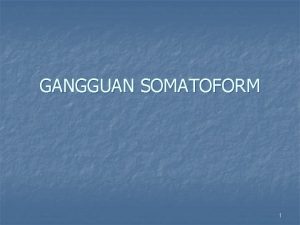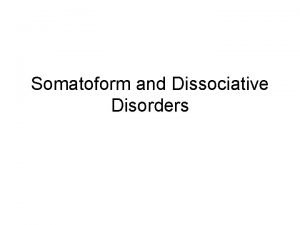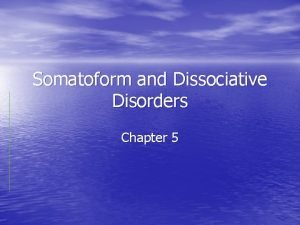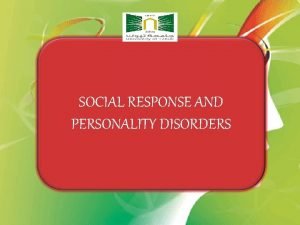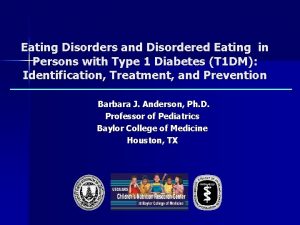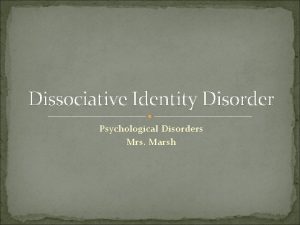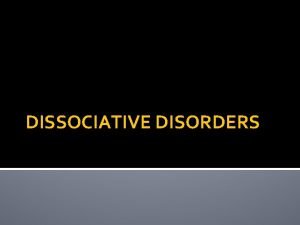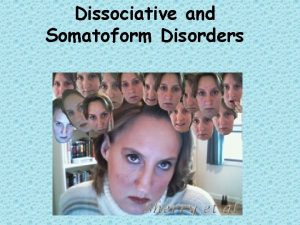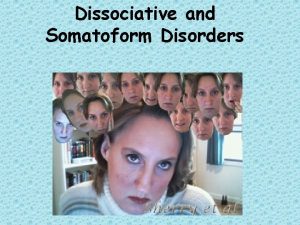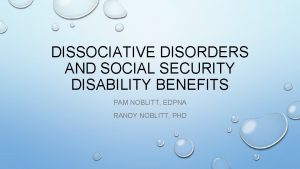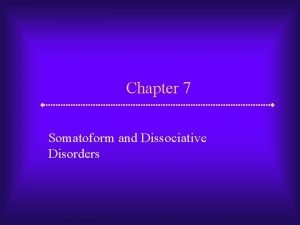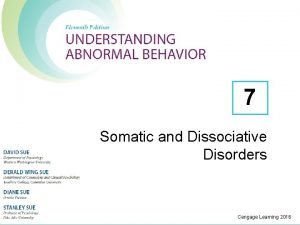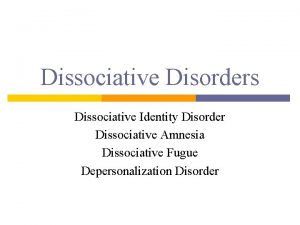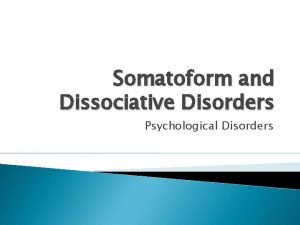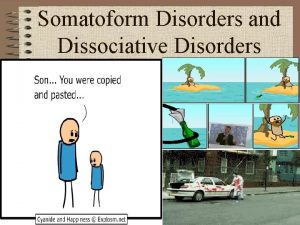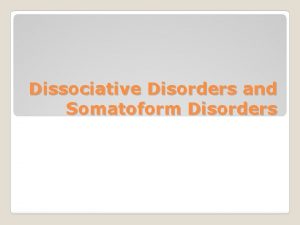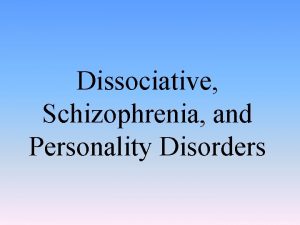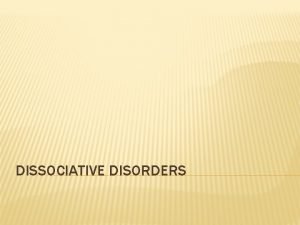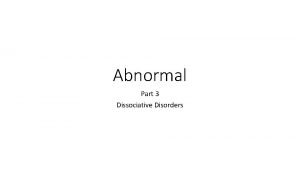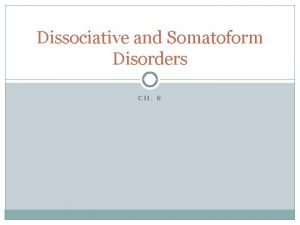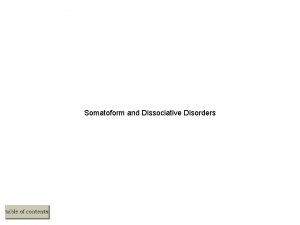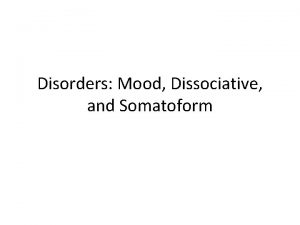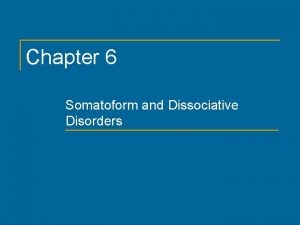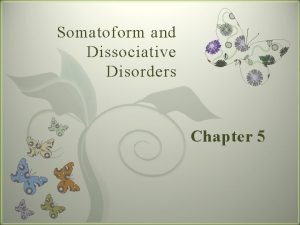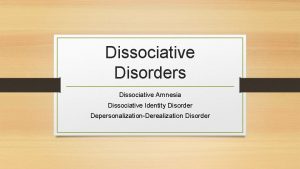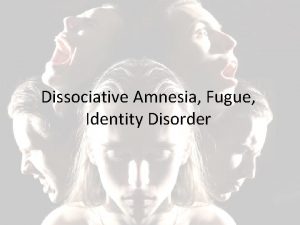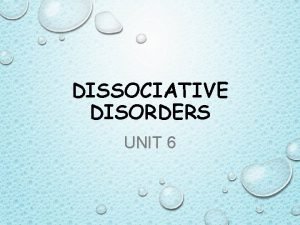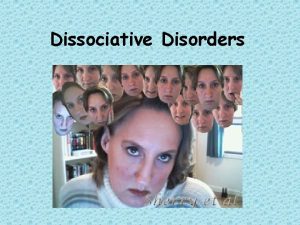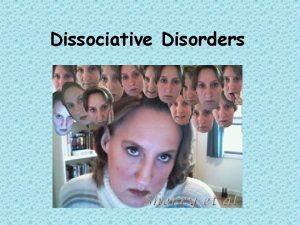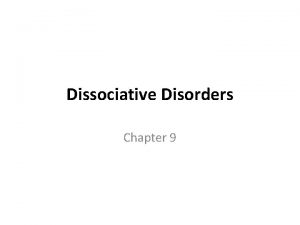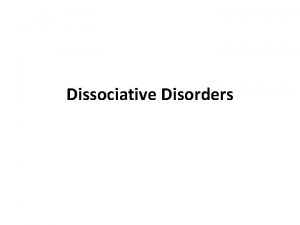Chapter 15 Somatoform and Dissociative Disorders Somatoform Disorders




























- Slides: 28

Chapter 15 Somatoform and Dissociative Disorders

Somatoform Disorders • Physical symptoms suggest a physical disorder. • Medical evaluation and diagnostic tests are negative. • Symptoms are linked to psychobiological factors. • Symptoms are not intentional or under conscious control. – In contrast to malingering and factitious disorder

Dissociative Disorders • Disturbances in the normally wellintegrated continuum of consciousness, memory, identity, and perception

Differentiation of Somatoform Disorders • Malingering – Intentionally producing symptoms to achieve an environmental goal • Factitious disorder – Fabrication of symptoms or self-inflicted injury to assume the sick role • Psychosomatic illness – A real medical condition affected by stress or psychological factors

Somatoform Disorders • Somatization disorder • Hypochondriasis • Pain disorder • Body dysmorphic disorder • Conversion disorder

Theories • Biological factors – Abnormal brain structure or neurotransmitter function • Genetic factors – Run in families • Cultural factors – Variability across cultures • Psychosocial factors – Psychoanalytic theory • Repression of conflict – Behavioral theory • Learned helplessness – Cognitive theory • Misinterpretation of body sensations

Somatization Disorder • Most frequent symptoms – Pain, dysphagia, nausea, bloating, constipation, palpitations, dizziness, shortness of breath • Significant functional impairment • Course of illness chronic and relapsing • Suicide threats and gestures common – Depression and anxiety common

Hypochondriasis • Misinterpretation of real physical sensations • Diagnostic tests are negative • Depression or anxiety disorders common • Chronic and relapsing, worse during periods of stress

Pain Disorder • Diagnostic testing rules out organic cause • Discomfort leads to impairment • Suicide a serious risk factor – Rate nine times higher • Usual sites of pain: head, face, lower back, pelvis • Depression, personality disorders, substance abuse common

Body Dysmorphic Disorder • Preoccupation with an imagined defective body part • Obsessional thinking and compulsive behavior • Impaired social, academic, or occupational functioning • Major depression, OCD, and social phobia common

Conversion Disorder • Deficits in voluntary motor or sensory functions • Common symptoms: involuntary movements, seizures, paralysis, abnormal gait, anesthesia, blindness, deafness • "La belle indifférence" versus distress • Comorbid conditions: depression, anxiety, other somatoform disorders, personality disorders • The most common somatoform disorder

Assessment • Symptoms and unmet needs • Voluntary control of symptoms – Symptoms not under voluntary control • Secondary gains • Cognitive style – Misinterpretation of stimuli • Ability to communicate feelings and emotional needs • Dependence on medication

Assessment Guidelines • Assess nature, location, onset, characteristics, and duration of symptoms • Assess ability to meet basic needs • Assess risks to safety • Determine if symptoms under voluntary control

Assessment Guidelines • Identify secondary gains • Assess cognitive style and ability to communicate feelings and needs • Assess type and amount of medications

Nursing Diagnosis • Ineffective coping, disturbed body image, chronic low self-esteem, selfcare deficits, pain – See table 15 -3 on page 261 entitled “Potential Nursing Diagnoses for Somatoform Disorders. ”

Outcome Criteria • Realistic and attainable • Structure outcomes in small steps to give the client hope for success.

Basic Level Nursing Interventions • Promotion of self-care activities • Health teaching – Assertiveness training • Case management – Brief, regular PCP appointments • Psychobiological interventions – SSRIs, short-term antianxiety agents – Relaxation techniques

Advanced Practice Interventions • Psychotherapy • Consultation with PCP

Dissociative Disorders • Depersonalization disorder • Dissociative amnesia • Dissociative fugue • Dissociative identity disorder – Formerly multiple personality disorder

Theory • Biological factors – Impaired limbic system and neurotransmitters (serotonin) • Genetic factors – Dissociative Identity Disorder (DID) • Cultural factors • Psychosocial factors – Learning theory: a learned method to survive overwhelming stress

Depersonalization Disorder • Alteration in perception of self • Disturbing experiences of – Feeling a sense of deadness of the body – Seeing oneself from a distance – Perceiving limbs to be larger or smaller than normal • Reality testing remains intact

Dissociative Amnesia • Inability to recall important personal information often of a traumatic nature – Generalized amnesia • No recall of entire life – Localized amnesia • No recall of a specific period – Selective amnesia • Recall some but not all events of a specific period

Dissociative Fugue • Sudden unexpected travel away from the customary locale • Precipitated by traumatic event • Inability to recall one's identity and some or all of the past • During fugue state tend to live simple, quiet lives • When remember former identity, become amnesic for time spent in fugue state

Dissociative Identity Disorder • Presence of two or more distinct personality states • Primary personality (host) usually not aware of alters • Alternate personalities (alters) or subpersonalities take control of behavior • Alters often aware of each other • Each alter thinks and behaves as a separate individual

Assessment • Self-identity and memory • Client history – Head injury, seizure disorder, abuse • Moods – Mood swings with DID • Use of alcohol and other drugs • Impact on client and family • Suicide risk – Self-harm

Basic Level Nursing Interventions • Milieu therapy – Safe environment • Health teaching – Stress management, coping strategies • Psychobiological interventions – Antidepressants, antianxiety agents

Advanced Practice Interventions • Cognitive-behavioral therapy • Psychodynamic psychotherapy

Evaluation: Successful Treatment • Client safety maintained • Anxiety reduced • Client functions at a higher level • Conflicts explored • Effective use of new coping strategies
 Chapter 29 somatic symptom and dissociative disorders
Chapter 29 somatic symptom and dissociative disorders Neurotic stress-related and somatoform disorders
Neurotic stress-related and somatoform disorders Neurotic personality disorder
Neurotic personality disorder Somatoform disorder nursing diagnosis
Somatoform disorder nursing diagnosis Somatoform disorders
Somatoform disorders Dissociative disorders
Dissociative disorders Types of dissociative disorders
Types of dissociative disorders Dissociative fugue,
Dissociative fugue, Somatization disorder
Somatization disorder Gangguan somatoform
Gangguan somatoform Hyperventilation treatment
Hyperventilation treatment Epidemiologi gangguan somatoform
Epidemiologi gangguan somatoform Associative and dissociative social process
Associative and dissociative social process Dissociative identity disorder
Dissociative identity disorder Dissociative fugue
Dissociative fugue Dissociative disorder
Dissociative disorder Dissociative disorder not otherwise specified
Dissociative disorder not otherwise specified Dissociative disorder not otherwise specified
Dissociative disorder not otherwise specified Dissociative identidy disorder
Dissociative identidy disorder Dissociative disorder not otherwise specified
Dissociative disorder not otherwise specified Dissociative disorder
Dissociative disorder Dissociation disorder
Dissociation disorder Disassociative amnesia
Disassociative amnesia Disociative fugue
Disociative fugue La belle indifference definition
La belle indifference definition Dissociative identity disorder social security disability
Dissociative identity disorder social security disability Dissociative amnesia
Dissociative amnesia Fugue dissociative
Fugue dissociative Cengage
Cengage

